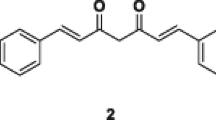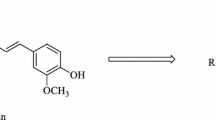Abstract
A series of novel curcumin (CC) analogs were synthesized by reacting substituted aldehydes with intermediates 4a and 4b. The inhibitory activities of these CC analogs were investigated on human cancer cells PC3, Bcap-37, and MGC-803 in vitro by MTT assay. The results showed that most of the title compounds displayed moderate to high levels of antitumor activities. Compound 5f, the most active CC analogs, has the IC50 values of 1.34 ± 0.28, 3.90 ± 0.36, and 0.86 ± 0.44 μM against the three human cancer cells assayed, respectively. Furthermore, subsequent fluorescence staining and flow cytometry analysis indicated compound 5f could induce apoptosis in PC3, Bcap-37, and MGC-803 cells, and the apoptosis ratio reachs the peak (27.1 %) in MGC-803 cells at 24 h after treatment at 10 μM.







Similar content being viewed by others
Abbreviations
- ADM:
-
Adriamycin
- AO/EB:
-
Acridine orange/ethidium bromide
- CC:
-
Curcumin
- 13C NMR:
-
13C nuclear magnetic resonance
- DMSO:
-
Dimethyl sulfoxide
- FCM:
-
Flow cytometry
- HCPT:
-
10-Hydroxyl camptothecine
- 1H NMR:
-
Proton nuclear magnetic resonance
- IR:
-
Infra-red
- MTT:
-
3-(4,5-Dimethylthiazol-2-yl)-2,5-diphenyltetrazolium bromide
References
Almanaa TN, Geusz ME, Jamasbi RJ (2012) Effects of curcumin on stem-like cells in human esophageal squamous carcinoma cell lines. BMC Complement Altern Med 12:195. doi:10.1186/1472-6882-12-195
Archana P, Sathishkumar P, Bharahi N (2011) In silico docking analysis of curcumin-an inhibitor for obesity. Int J Pharm Bio Sci 4:224–235
Bachmeier BE, Mirisola V, Romeo F, Generoso L, Esposito A, Dell’eva R, Blengio F, Killian PH, Albini A, Pfeffer U (2010) Reference profile correlation reveals estrogen-like trancriptional activity of curcumin. Cell Physiol Biochem 26:471–482
Chainani-Wu N (2003) Safety and anti-inflammatory activity of curcumin: a component of tumeric (Curcuma longa). J Altern Complement Med 9:161–168
Fei B, Chi AL, Weng Y (2013) Hydroxycamptothecin induces apoptosis and inhibits tumor growth in colon cancer by the downregulation of survivin and XIAP expression. World J Surg Oncol 11:120. doi:10.1186/1477-7819-11-120
Jayaprakasha GK, Rao LJ, Sakariah KK (2006) Antioxidant activities of curcumin, demethoxycurcumin and bisdemethoxycurcumin. Food Chem 4:720–724
Kasibhatla S, Amarante-Mendes GP, Finucane D, Brunner T, Bossy-Wetzel E, Green DR (2006) Acridine orange/ethidium bromide (AO/EB) staining to detect apoptosis. CSH Protoc. doi:10.1101/pdb.prot4493
Khanna S, Park HA, Sen CK, Golakoti T, Sengupta K, Venkateswarlu S, Roy S (2009) Neuroprotective and anti-inflammatory properties of a novel demethylated curcuminoid. Antioxid Redox Signal 11:449–468. doi:10.1089/ARS.2008.2230
Kohli K, Ali J, Ansari MJ, Raheman Z (2005) Curcumin: a natural anti-inflammatory agent. Indian J Pharmacol 3:141–147
Lee JY, Lee YM, Chang GC, Yu SL, Hsieh WY, Chen JJ, Chen HW, Yang PC (2011) Curcumin induces EGFR degradation in lung adenocarcinoma and modulates p38 activation in intestine: the versatile adjuvant for gefitinib therapy. PLoS One 6:e23756
Lin CL, Lin JK (2008) Curcumin: a potential cancer chemopreventive agent through suppressing NF-κB signaling. J Cancer Mol 4:11–16
Liu G, Song BA, Sang WJ, Yang S, Jin LH, Ding X (2004) Chin J Org Chem 10:1296–1299
Liu G, Yang S, Song BA, Xue W, Hu DY, Jin LH, Lu P (2006) Microwave assisted synthesis of N-arylheterocyclic substituted-4-aminoquinazoline derivatives. Molecules 11:272–278
McGookin A, Heilbron IM (1924) CCLXXV.-The isomerism of the styryl alkyl ketones. Part I. The isomerism of 2-hydroxystyryl methyl ketone. J Chem Soc Trans 125:2099–2105
Menon VP, Sudheer AR (2007) Antioxidant and anti-inflammatory properties of curcumin. Adv Exp Med Biol 595:105–125
Ravindran J, Prasad S, Aggarwal BB (2009) Curcumin and cancer cells: how many ways can curry kill tumor cells selectively? AAPS J 11:495–510. doi:10.1208/s12248-009-9128-x
Ringman JM, Frautschy SA, Cole GM, Masterman DL, Cummings JL (2005) A potential role of the curry spice curcumin in Alzheimer’s disease. Curr Alzheimer Res 2:131–136
Sa G, Das T (2008) Anti-cancer effects of curcumin: cycle of life and death. Cell Div 3:14
Senft C, Polacin M, Priester M, Seifert V, Kögel D, Weissenberger J (2010) The nontoxic natural compound curcumin exerts anti-proliferative, anti-migratory, and anti-invasive properties against malignant gliomas. BMC Cancer 10:491
Shibata H, Yamakoshi H, Sato A, Ohori H, Kakudo Y, Kudo C, Takahashi Y, Watanabe M, Takano H, Ishioka C, Noda T, Iwabuchi Y (2009) Newly synthesized curcumin analog has improved potential to prevent colorectal carcinogenesis in vivo. Cancer Sci 100:956–960
Shukla PK, Khanna VK, Ali MM, Khan MY, Srimal RC (2008) Anti-ischemic effect of curcumin in rat brain. Neurochem Res 33:1036–1043
Sukardiman H, Widyawaruyanti A, Sismindari, Zaini NC (2007) Apoptosis inducing effect of andrographolide on TD-47 human breast cancer cell line. Afr J Tradit Complement Altern Med 4:345–351
Wilken R, Veena MS, Wang MB, Srivatsan ES (2011) Curcumin: a review of anti-cancer properties and therapeutic activity in head and neck squamous cell carcinoma. Mol Cancer 10:12
Wu J, Yi WS, Jin LH, Hu DY, Song BA (2012) Antiproliferative and cell apoptosis-inducing activities of compounds from Buddleja davidii in MGC-803 cells. Cell Div 7:20
Yamakoshi H, Ohori H, Kudo C, Sato A, Kanoh N, Ishioka C, Shibata H, Iwabuchi Y (2010) Structure-activity relationship of C5-curcuminoids and synthesis of their molecular probes thereof. Bioorg Med Chem 18:1083–1092
Yang S, Liang N, Li H, Xue W, Hu D, Jin L, Zhao Q, Yang S (2012) Design, synthesis and biological evaluation of novel betulinic acid derivatives. Chem Cent J 6:141
Yang S, Liu M, Liang N, Zhao Q, Zhang Y, Xue W, Yang S (2013) Discovery and antitumor activities of constituents from Cyrtomium fortumei (J.) Smith rhizomes. Chem Cent J 7:24
Yuan K, Song B, Jin L, Xu S, Xu X, Yang S (2011) Synthesis and biological evaluation of novel 1-aryl, 5(phenoxy-substituted)aryl-1,4-pentadien-3-one derivatives. Med Chem Commun 2:585–589
Zahidah AF, Faizah O, Aqilah N, Anna KT (2012) Curcumin as an anti-arthritic agent in collagen-induced arthritic sprague-dawley rats. Sains Malays 41:591–595
Zhai DD, Supaibulwatana K, Zhong JJ (2010) Inhibition of tumor cell proliferation and induction of apoptosis in human lung carcinoma 95-D cells by a new sesquiterpene from hairy root cultures of Artemisia annua. Phytomedicine 17:856–861
Acknowledgments
The authors wish to thank the Guizhou Province Production Technology & Innovation Capacity Building for Fine Fruits (No. 20104009) and the Science and Technology Major Specialized Projects for “Significant New Drugs Creation” of the 12th 5-year Plan (2012ZX09101231-004) for the financial support.
Conflict of interest
None.
Author information
Authors and Affiliations
Corresponding author
Additional information
Hui Luo and Shengjie Yang have contributed equally to this study.
Rights and permissions
About this article
Cite this article
Luo, H., Yang, S., Zhao, Q. et al. Synthesis and antitumor properties of novel curcumin analogs. Med Chem Res 23, 2584–2595 (2014). https://doi.org/10.1007/s00044-013-0854-3
Received:
Accepted:
Published:
Issue Date:
DOI: https://doi.org/10.1007/s00044-013-0854-3




